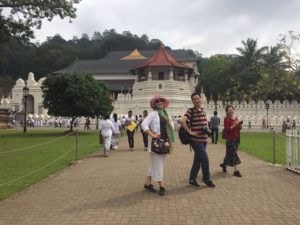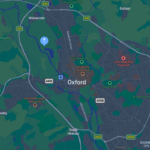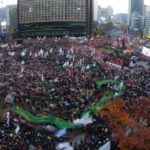Buddhist Temple: Place of Worship and Tourist Consumption
Sri Dalada Maligawa (Sinhala: ශ්රී දළදා මාළිගාව) or The Temple of the Sacred Tooth Relic is a Buddhist temple in the city of Kandy, Sri Lanka. It is located in the royal palace complex which houses the Relic of the tooth of Buddha. It is considered the most famous Buddhist temple and pilgrimage site in the country, where the majority of local population are Buddhists.
The Temple is open to all local people free of charge. Every day huge numbers of locals in white clothes (the sacred colour standing for purity) come to sit in the Temple and pray. At the same time, due to the Temple’s value as a world heritage site, it attracts tourists from all over the world and almost all the package tours feature it as a major attraction in the itinerary. Many Chinese advertisements describe the Temple and Sri Lanka as a whole using words like ‘seeking’, ‘peace’, ‘purity’ and ‘faith’. Unlike the locals, foreign tourists are charged an entrance fee of $10. Tourists and locals also come into the yard of the Temple through different entrance. The Temple also provide supporting services like tour guiding and safekeeping of shoes exclusively for tourists.
Inside the Temple, local people in white, colourful tourists, professional ‘temple guides’ and ‘temple police’ who keep an eye on ‘illegal tour guiding’ share the same space, making the place even more crowded as it simultaneously functions as a place of worship as well as a profit-making tourist site. In the descriptions of tour guides, the Temple is packaged as a historical heritage, a museum, a cultural park, and eventually an object of tourist gaze. Indeed, in such a popular pilgrim site, local Buddhists in white clothing are also becoming part of the live display of Buddhist culture and frequently captured by the exoticism-seeking cameras of tourists.
Interestingly, another world heritage and Buddhist temple in Dambulla (northeast of Sri Lanka), which used to open free of charge to everyone, recently started to share the cake of profitable tourist market by charging foreigners an entrance fee. In order to better manage fee collection, the Temple also artificially separated the entrance of locals and tourists. It banned access of foreign tourists from the main entrance and directed all the tour buses to the other side of the mountain, where the newly established ‘foreigner entrance’ was located. Stalls selling flowers, postcards and souvenirs also moved with the tourist entrance.
Therefore, we could see that on the one hand, the Buddhist temples are sacred pilgrim sites for the local population; while on the other hand, they are also at the core of commercial operation, providing a range of supporting services and generating small local businesses. It can be argued that in practice the temple itself is commoditised as an object of tourist gaze, and we can see the resulting tension between the two different roles.
Contributed by WenleiHuang on 29/01/2018







